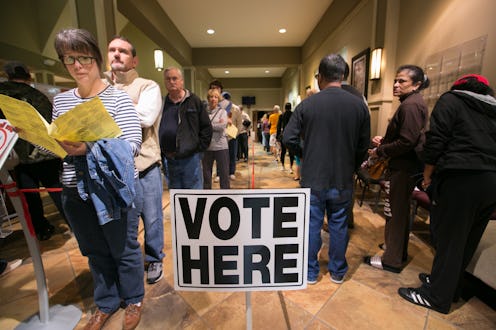News
Voter Turnout In The 2018 Midterms Was Even More Significant Than You Thought

Before voters headed to the polls last month, 2018 was forecasted to be a historic year for midterm voter participation. But like weather forecasts, predictions about voter turnout can sometimes turn out to be wrong. However, new data suggests that 2018 was indeed a landmark year for civic engagement. In fact, the 2018 midterm reportedly had the highest voter turnout of any midterm election in more than a century.
According to turnout rates recorded by the United States Elections Project, an online information source regarding the U.S. electoral system maintained by University of Florida political science associate professor Michael McDonald, 118,049,275 ballots were cast in the 2018 midterm election. That means that 50.1 percent of eligible voters turned up to vote last month and that, as Vox pointed out, the 2018 midterms saw the highest percentage of midterm voter turnout in more than a century.
According to Vox's Emily Stewart, midterm elections haven't seen such high turnout numbers since 1914, when voter turnout topped 50.4 percent. But voter turnout in 1914 was likely boosted by that fact that the year was the first in which American voters were able to directly elect members of the U.S. Senate.
But while turnout in the 2018 midterm fell short of the percentage recorded in 1914, it did surpass turnout rates recorded in other years with noteworthy levels of civic engagement. In 1966, for example, when the United States was embroiled in the Vietnam War abroad and the civil right movement at home, nearly 49 percent of the nation's voting-age population cast ballots in the midterms, according to McDonald.
While midterm elections aren't generally known for inspiring hordes of people to cast ballots, electoral competitiveness, a recent uptick in partisan politics, and indeed, even President Donald Trump were expected to ultimately drive more people to the polls. In fact, prior to the election, McDonald told NPR that he expected to see voter turnout fall somewhere between 45 to 50 percent. "It's probably going to be a turnout rate that most people have never experienced in their lives for a midterm election," he said.
According to FiveThirtyEight, only 40 percent of eligible voters actually show up to vote in midterm elections, on average. But some years have seen voter turnout dip below 40 percent. In 2014, for example, only 36.4 percent of eligible voters cast ballots. At the time, it was the worst voter turnout rate seen in more than 70 years. Voter turnout was similarly low in 2010, with only 36.9 percent of eligible voters casting ballots, according to the Pew Research Center.
But flailing voter turnout in the midterms — as compared to presidential elections — isn't a new trend. According to the Pew Research Center, voter turnout has, since the 1840s, regularly dropped during midterms. In 2008, for example, 57.1 percent of the voting-age population are reported to have cast ballots. However, when midterm elections rolled around two years later in 2010, only 36.9 percent of the voting-age population voted. But in 2012, 53.7 percent showed up to cast ballots in the presidential election.
Indeed, we'll likely see a similar pattern between 2016 and 2020. While the 2018 midterms brought 50.1 percent of eligible voters out, the 2016 presidential election saw a turnout of roughly 58 percent. With Trump likely running for reelection in 2020, voter turnout is expected to spike again.